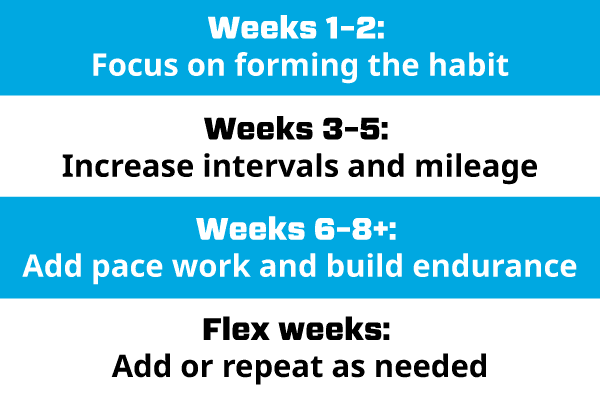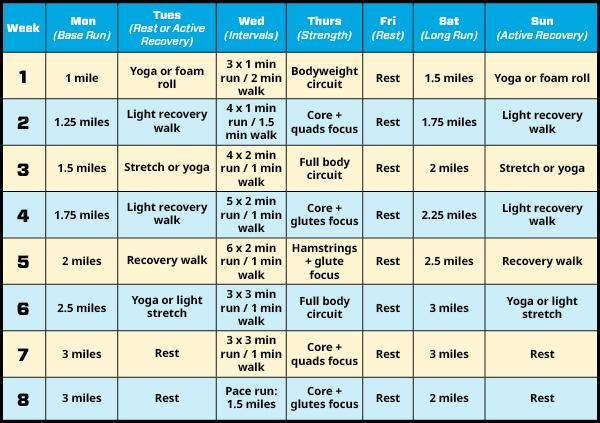HOW TO TRAIN FOR A 5K: A BEGINNER’S GUIDE TO RUNNING SMARTER, STRONGER AND SAFER
Fitness Tips
Jul 07, 2025 • 8min read
Starting something new can feel intimidating—especially when it comes to running. But that’s what makes the 5K such a popular choice: it’s approachable, achievable and designed to help you build a strong foundation, even if you’ve never run a mile before. Whether you’re chasing your first finish line or looking to fine-tune your performance, this guide will help you train smarter for your next 5K, with strategies that make the journey as rewarding as the destination.
WHAT YOU WILL LEARN
Estimated Reading Time: 8 minutes
WHAT IS A 5K TRAINING PLAN?

A 5K training plan is a structured, week-by-week guide designed to help you prepare for running a 5K, a 3.1-mile race. It includes a mix of easy runs, walk/run intervals, long runs and rest days to gradually build your endurance and improve your pace. Some plans may include strength training to support overall fitness and injury prevention.
Why Structure Matters in Your 5K Training Plan
A well-structured 5K training plan helps ensure every step you take moves you closer to your goal, without unnecessary setbacks.
- Prevents overtraining: Random workouts or too many intense runs can lead to fatigue and burnout. Structure balances hard days with recovery, keeping your body fresh and responsive.
- Builds lasting habits: Having a predictable schedule makes it easier to stay consistent. Knowing what’s coming makes you more likely to show up and follow through.
- Reduces injury risk: Gradual progression in distance and intensity gives your muscles, joints and connective tissues time to adapt. This lowers the chance of strains, sprains and other overuse injuries.
- Helps track progress: A plan with benchmarks helps you see your improvement over time. Whether completing a longer run or recovering faster, those small wins build confidence and motivation.
HOW LONG DOES IT TAKE TO TRAIN FOR A 5K?
Most beginner plans last 6 to 10 weeks, but there’s no one-size-fits-all timeline. What matters most is finding a rhythm that works for you, one that lets you train smartly, stay consistent and build real, lasting strength.
Here’s a general outline of what you can expect as you build up to race day:
- Weeks 1–2: Focus on forming the habit
- Weeks 3–5: Increase intervals and mileage
- Weeks 6–8+: Add pace work and build endurance
- Flex weeks: Repeat a week or take extra rest when life happens. These are built-in resets to keep you consistent, not perfect.
YOUR 5K WEEKLY TRAINING SCHEDULE
Consistency is key, but balance is just as important. Here’s a sample 7-day plan that gradually builds up your endurance and strength each week:

Week 1:
- Mon (Base Run): 1 mi
- Tues (Rest or Active Recovery): Yoga or foam roll
- Wed (Intervals): 3 x 1 min run / 2 min walk
- Thurs (Strength): Bodyweight circuit
- Fri (Rest): Rest
- Sat (Long Run): 1.5 mi
- Sun (Active Recovery): Yoga or foam roll
Week 2:
- Mon (Base Run): 1.25 mi
- Tues (Rest or Active Recovery): Light recovery walk
- Wed (Intervals): 4 x 1 min run / 1.5 min walk
- Thurs (Strength): Core + quads focus
- Fri (Rest): Rest
- Sat (Long Run): 1.75 mi
- Sun (Active Recovery): Light recovery walk
Week 3:
- Mon (Base Run): 1.5 mi
- Tues (Rest or Active Recovery): Stretch or yoga
- Wed (Intervals): 4 x 2 min run / 1 min walk
- Thurs (Strength): Full body circuit
- Fri (Rest): Rest
- Sat (Long Run): 2 mi
- Sun (Active Recovery): Stretch or yoga
Week 4:
- Mon (Base Run): 1.75 mi
- Tues (Rest or Active Recovery): Light recovery walk
- Wed (Intervals): 5 x 2 min run / 1 min walk
- Thurs (Strength): Core + glutes focus
- Fri (Rest): Rest
- Sat (Long Run): 2.25 mi
- Sun (Active Recovery): Light recovery walk
Week 5:
- Mon (Base Run): 2 mi
- Tues (Rest or Active Recovery): Recovery walk
- Wed (Intervals): Hamstrings + glutes focus
- Thurs (Strength): Bodyweight circuit
- Fri (Rest): Rest
- Sat (Long Run): 2.5 mi
- Sun (Active Recovery): Recovery walk
Week 6:
- Mon (Base Run): 2.5 mi
- Tues (Rest or Active Recovery): Yoga or light stretch
- Wed (Intervals): 3 x 3 min run / 1 min walk
- Thurs (Strength): Bodyweight circuit
- Fri (Rest): Rest
- Sat (Long Run): 1.5 mi
- Sun (Active Recovery): Yoga or foam roll
Week 7:
- Mon (Base Run): 2.5 mi
- Tues (Rest or Active Recovery): Rest
- Wed (Intervals): 3 x 3 min run / 1 min walk
- Thurs (Strength): Core + quads focus
- Fri (Rest): Rest
- Sat (Long Run): 3 mi
- Sun (Active Recovery): Rest
Week 8:
- Mon (Base Run): 3 mi
- Tues (Rest or Active Recovery): Yoga or foam roll
- Wed (Intervals): Pace run: 1.5 mi
- Thurs (Strength): Core + glutes focus
- Fri (Rest): Rest
- Sat (Long Run): 2 mi
- Sun (Active Recovery): Rest
Key Workouts Explained
- Base Runs: These are shorter, steady runs at a controlled pace that may challenge you slightly more than a conversation pace. They’re great for building your running rhythm and aerobic efficiency.
- Intervals: Short bursts of faster running followed by periods of rest or walking. Intervals train your heart and lungs to handle more intensity, and make your overall pace feel easier.
- Long Runs: These are your slow-and-steady sessions. You should be able to hold a conversation comfortably during these runs. The focus is on increasing time on your feet to build endurance without overexertion.
- Strength Days: Focused routines that target core, glutes, hamstrings and full-body balance to build a resilient and powerful stride.
- Active Recovery: Low-impact movement like walking, cycling or yoga that help blood flow, ease soreness and support your next workout without adding stress.
STRENGTH TRAINING FOR RUNNERS
Strength training helps you run faster by building muscle power and improving coordination. Stronger legs and core muscles help you maintain better running form, push off the ground more efficiently and reduce overall fatigue. This means you can hold your pace longer and recover faster between runs. Aim for two sessions a week to support your performance and protect against injury.
Must-Do Moves
- Goblet squats
- Lunges (forward, reverse, walking)
- Plank variations
- Glute bridges and hip thrusts
- Deadlifts (kettlebell or barbell)
PACING STRATEGIES THAT PREVENT BURNOUT
Running too fast, too soon, is one of the top reasons beginner runners quit. Instead of worrying about your mile time, start with effort-based pacing.
Smart Pacing Tips for Beginner Runners
- Use the talk test: For long runs, aim to keep your pace slow enough to carry on a conversation. This ensures you’re not overexerting and helps build endurance without burnout.
- Start slower than you think: Most runners go out too fast. Begin at a pace that feels almost too easy; you can always pick it up later.
- Gradually increase run time: Instead of jumping into nonstop running, increase your run intervals weekly while reducing walk breaks. This helps your body adapt safely.
- Save your push for race day: Not every run needs to be intense. Stick to your pacing plan to stay fresh, avoid injury and peak when it matters most.
RECOVERY = RESULTS
Training is only half the equation. Recovery is where the magic happens. Skipping can stall your progress, increase injury risk and leave you feeling drained. Smart runners treat recovery like a workout and EōS makes it easier to prioritize with built-in support.
How to Recover Like a Pro
Smart recovery helps you stay consistent and injury-free. Here’s how to make the most of your downtime—plus how EōS amenities can support your recovery routine:
- Get 7–9 hours of sleep: Quality sleep is your best recovery tool. It helps repair muscle tissue, regulate energy levels and boost your mood.
- Refuel with carbs and protein: After your run, give your body what it needs—carbs to replenish energy and protein to rebuild muscle.
- Use yoga or walking on active recovery days: Light movement helps flush out lactic acid and keeps your body primed for your next workout. G-Fit yoga classes and a walk on the treadmill are perfect low-intensity options.
- Tap into EōS recovery amenities: Use the sauna to ease tightness, stretch out on the turf, or unwind with a HydroMassage (at select locations) after long or intense sessions.
MISTAKES TO AVOID WHEN TRAINING FOR A 5K
Even the best plan can be derailed by a few common beginner mistakes.
Steer Clear Of:
- Skipping warmups or cooldowns: Jumping straight into a run or stopping abruptly can shock your muscles and lead to injury. Always start with dynamic movements and end with light stretching.
- Running too fast on base days: Pushing the pace might feel good, but base runs are about control and consistency. Running too hard, too often, can derail your training.
- Ignoring rest days: Rest is when your body rebuilds and adapts. Skipping doesn’t make you tougher; it puts you at risk for burnout and injury.
- Forgetting strength workouts: Running alone won’t keep you injury-free. Strength training balances your body, builds resilience and improves your stride.
- Poor nutrition before or after runs: Fueling matters. Eat a light carb-rich snack before your run and refuel with protein and carbs afterward to speed up recovery.
START YOUR 5K JOURNEY STRONG WITH EōS FITNESS
Training for a 5K is easier when you can access everything that keeps your body strong, resilient and supported. EōS Fitness offers more than just treadmills. Whether prepping for race day or learning to love the run, you’ll find the tools, equipment and recovery resources to keep going.
Whether you’re lacing up for your first race or looking to beat your personal best, there’s an EōS membership that fits your goals, your lifestyle and your training pace.








